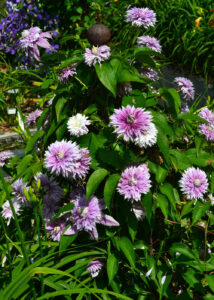 Eddie Smith
Eddie Smith
Clematis vines are one of my favorite climbing plants, known for their abundant and strikingly colorful flowers that can transform any vertical space into a breathtaking floral display.
While visiting my friend, Kay Klein, in Picayune, Mississippi, I saw several beautiful varieties thriving in her garden.
Clematis leaves are usually compound with 3-5 leaflets and are usually lush green in color; some varieties have a variegated pattern. This vine grows best in fertile, well-drained soil and should be watered regularly to keep the soil moist but not soggy.
Clematis grows well in full sun to partial shade, although some species are adapted to shady conditions.
Flowering times vary widely, with some species flowering in early spring, others in summer, and others in fall, providing visual interest throughout the growing season.
When caring for clematis, it is important to understand the need for pruning.
Clematis are divided into three categories based on their flowering habit: Group 1 flowers on old wood and should be pruned after flowering.
Group 2 flowers on both old and new wood and requires light pruning in early spring and after the first bloom, while Group 3 flowers on new wood and benefit from heavy pruning in early spring.
One of my favorite flowers in Kay's garden is Clematis Josephine, a unique variety known for its beautiful, multi-layered blooms that bloom from late spring through early fall.
This deciduous perennial vine reaches heights of 8 to 10 feet. Its flowers are a stunning mix of mauve and lilac pink and feature broad outer petals and wavy, thin inner petals that form a pom-pom appearance.


Clematis vines, like this Josephine, are climbing plants known for their prolific, colorful blooms that can transform any vertical space into a breathtaking floral display. Photo by Eddie Smith, courtesy of Michigan State University Extension
Being in pruning group 2, Josephine requires light pruning in late winter or early spring to encourage vigorous growth, with additional pruning after the first flowering to encourage a second bloom.
I was impressed with the Clematis Withley in Kay's garden, in pruning group 2. This variety is treasured for its delicate flowers that add elegance to any garden in which it is planted.
This deciduous vine usually reaches a height of 6 to 8 feet and flowers appear in late spring and continue to bloom into early summer.
The flowers are a soft lavender blue with a pale center and are about 4 to 6 inches in diameter.
Clematis Wisley has broad, slightly wavy petals and produces attractive open flowers that contrast beautifully with the dark green compound leaves.
Clematis Luther Burbank is one of my favorites from Kay's collection. It's a hardy variety beloved for its large, striking flowers and hardy nature. This deciduous climbing plant grows to a height of 10-15 feet.
Striking deep purple-purple flowers bloom from early summer through fall. The blossoms are 6-8 inches in diameter, with velvety overlapping petals that create an eye-catching sight. The flower centers feature contrasting creamy white stamens that add to their visual appeal.
As part of pruning group 3, Luther Burbank benefits from hard pruning in early spring. Cut back to about 12 inches above ground level to encourage vigorous growth and abundant flowering.
Clematis Ernest Markham is also in pruning group 3 and is known for its intense magenta-red flowers.
This deciduous vine reaches heights of 10 to 15 feet. Large, velvety flowers, 4 to 6 inches in diameter, bloom throughout the summer and into early fall. Each flower has broad, overlapping petals with slightly ruffled edges and a contrasting cream-colored stamen in the center.
Kay Klein's Garden Clematis Vines create stunning floral displays with their graceful tendrils, whether used to decorate garden structures or as a ground cover. Try it in your own home to bring elegance and vibrant color to your garden landscape.
Eddie Smith is a horticulture expert and Pearl River County Coordinator for the Mississippi State University Extension Service, as well as the host of a popular Southern Gardening television show.
Quality, in-depth journalism is essential to a healthy community. The Dispatch delivers the Golden Triangle's most thorough reporting and insightful commentary, but we need your help to continue our work. In the past week, our reporters posted 30 stories to cdispatch.com. To support local journalism and your community, please consider subscribing to our website for $2.30 a week.


